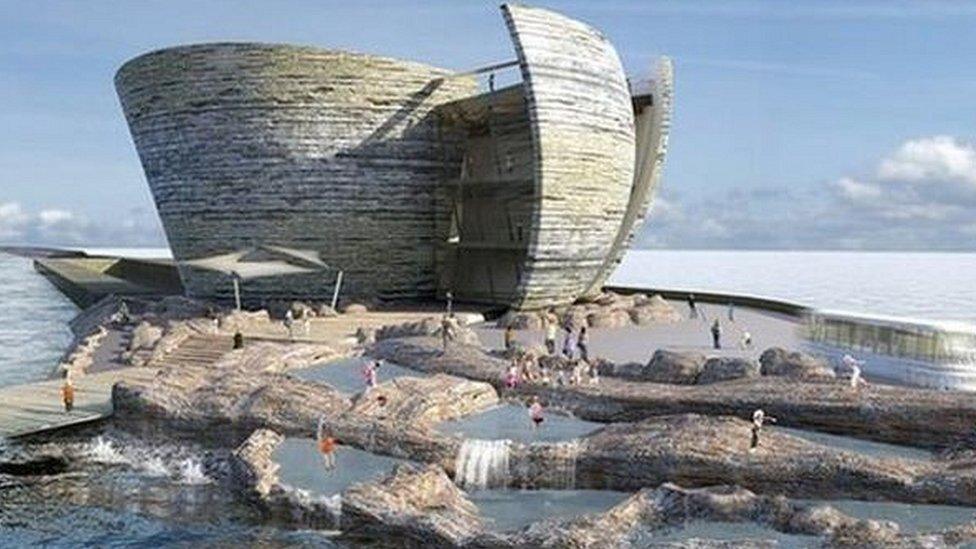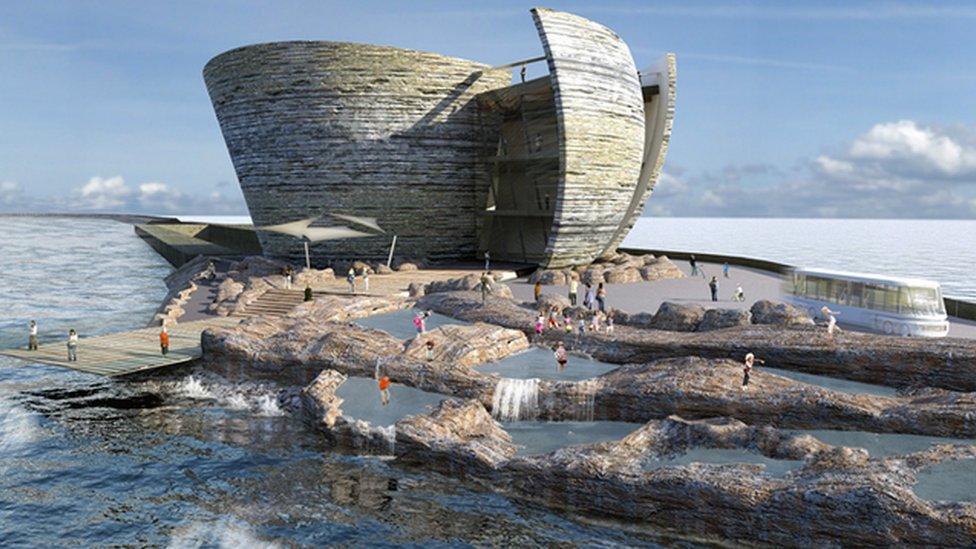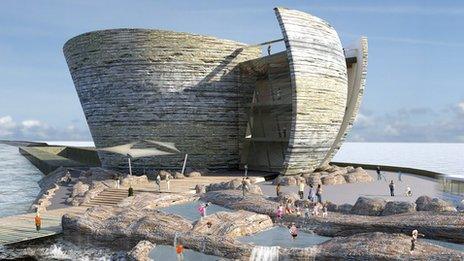Swansea Tidal Lagoon: Questions raised over engineering
- Published

Doubts have been raised about some of the engineering behind Swansea's £1bn tidal lagoon project.
It comes after Prime Minister David Cameron admitted his enthusiasm for tidal had been "reduced" as the UK government tries to agree a subsidy.
BBC Wales has heard reservations relate to the proposed lagoon's modelling and turbine engineering.
But Tidal Lagoon Power said questions on the engineering and environmental impact had been addressed in depth.
The proposals are for 16 turbines, placed roughly a mile out to sea, to generate 320 megawatt of power - which would then be converted into electricity.
The turbines are key to this whole project succeeding - the engineering has to maximise the power generated without harming a precious inter-tidal environment.
It is a brand new technology on this scale and experts say it has to be spot on to be both cost effective and to avoid unwanted side effects ranging from plumes of water heading towards the Mumbles to sediment building.
Roger Griffiths lives in the marina and is a retired mechanical engineer with Swansea University and a former professor at the University of California.
He believes more testing of the turbines in the right conditions is needed before anyone could be sure they would work efficiently.
'Not suited'
"What we don't have are some practical measurements of the performance of these turbines under difficult conditions - the lowest depth of water and the use of the turbines in reverse flow, when the tide is coming in, back to front. They're not suited in shape to cope with flows in that direction," he said.
Prof Griffiths added: "All these theoretical estimates are fine but they're guessing - intelligent guessing - about the efficiencies of these turbines."
Dr Bob Allen, a former tidal engineer at Swansea University has similar concerns, saying there has been an assumption the turbines would work to the same efficiency with the tide flowing in both directions.
"When the flow is going in the wrong direction the efficiency will be very low, but they've assumed that they're going to have the high efficiency for all the time - and that's just not going to happen," he said.
Others question the modelling to assess the wake of water from the turbines once they are in the bay.
Prof Roger Falconer explains how the wake from the turbines is an important consideration
Prof Roger Falconer, a water management expert from Cardiff University, said Wales had huge potential for tidal but he queried the modelling on tidal currents in Swansea's bay.
'Validated'
He supports building the Swansea lagoon but said it was important to ensure the location was right to minimise the huge, high-velocity wake which could be created by the turbines.
"The more you spread these turbines out, the more you can reduce this wake dramatically and any potential re-circulation effects," he said.
"It's a matter of getting this balance right and we need to get it right before we go on to build any more lagoons."
He said he hoped some of the design aspects could be improved so the project could go ahead.
Dr George Aggidis, an engineer at Lancaster University, is another supporter of tidal energy.
"Manufacturers are really moving very fast and coming up with new solutions for turbines to operate at very high efficiency so they can increase significantly the annual power that's generated."
But he said there still needed to be further research into modelling the turbines in Swansea.
"It's a new piece of research that has to take place worldwide - work that could easily take up to two years but results could start feeding into current projects immediately."
Tidal Lagoon Power said questions on the engineering and environmental impact had been addressed in depth by experts through a robust planning and validation process.
A spokesman said: "The Swansea Bay Tidal Lagoon is a world-first that employs proven technology in a new way.
"The project has been awarded a Development Consent Order and its design has been validated through independent technical adjudication on behalf of government and on behalf of the investors who are backing it.
"We are working in partnership with respected organisations in the fields of global engineering, industry and construction to prepare the project for delivery."

How would the lagoon work?
Watch Tidal Lagoon Power's video of how the turbines would work
A six-mile long seawall loops two miles (3.2 km) out to sea from close to the mouth of the River Tawe and Swansea Docks and makes landfall close to Swansea University's new Fabian Way campus to the east.
It would house 16 underwater turbines generating electricity on both the rising and falling tide.
Enough renewable power would be produced for 155,000 homes (equivalent to 90% of Swansea Bay's annual domestic electricity use) for 120 years.
Source: Tidal Lagoon Power Ltd

- Published13 January 2016

- Published15 October 2015

- Published7 February 2014
